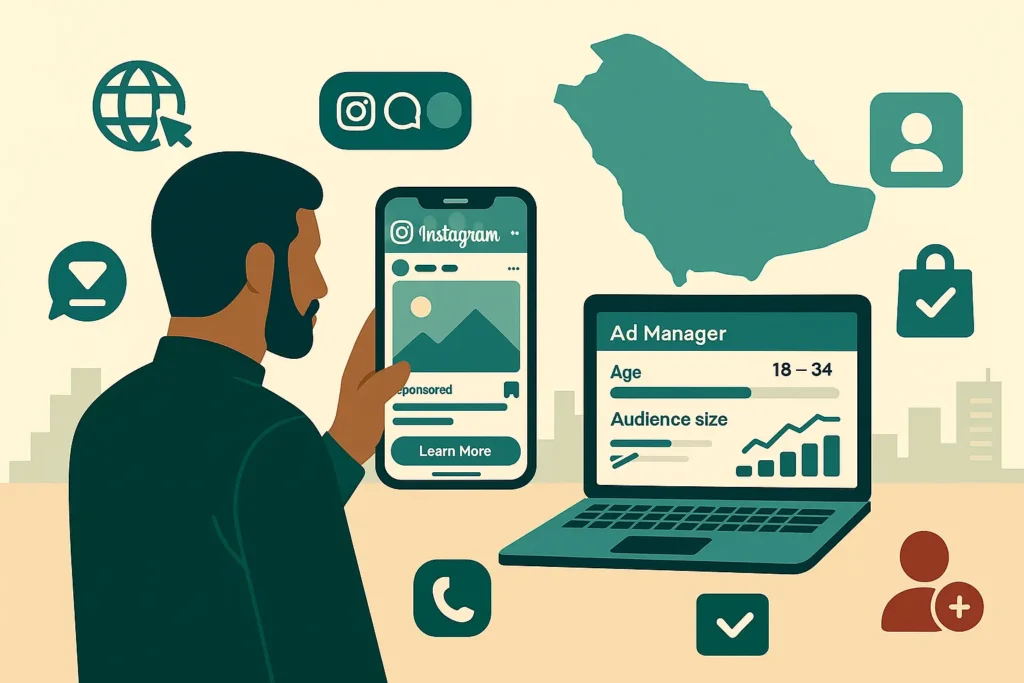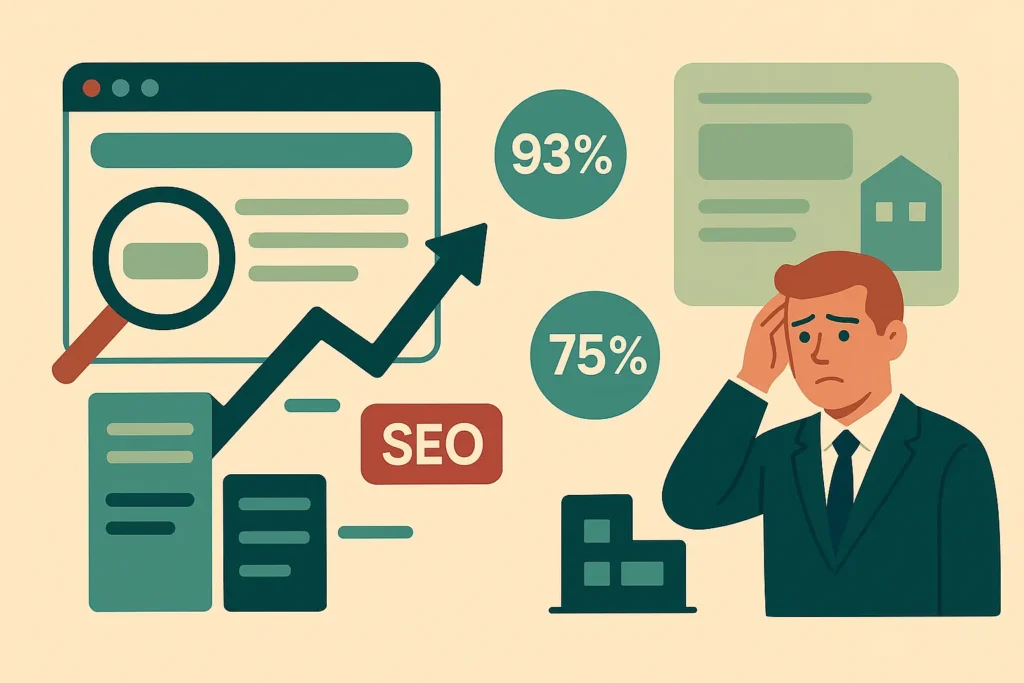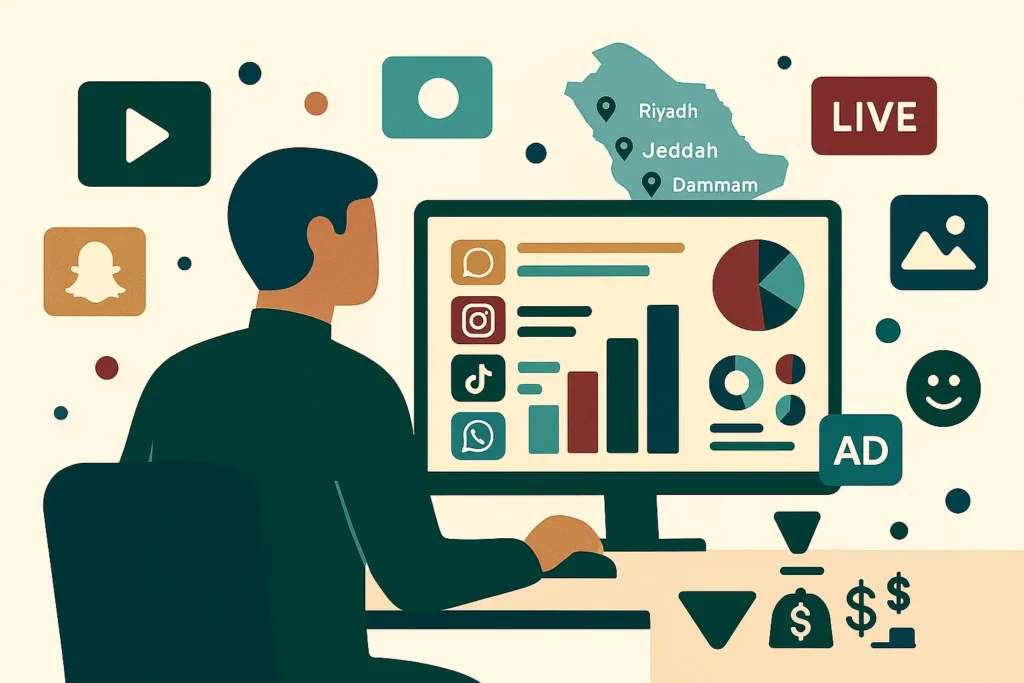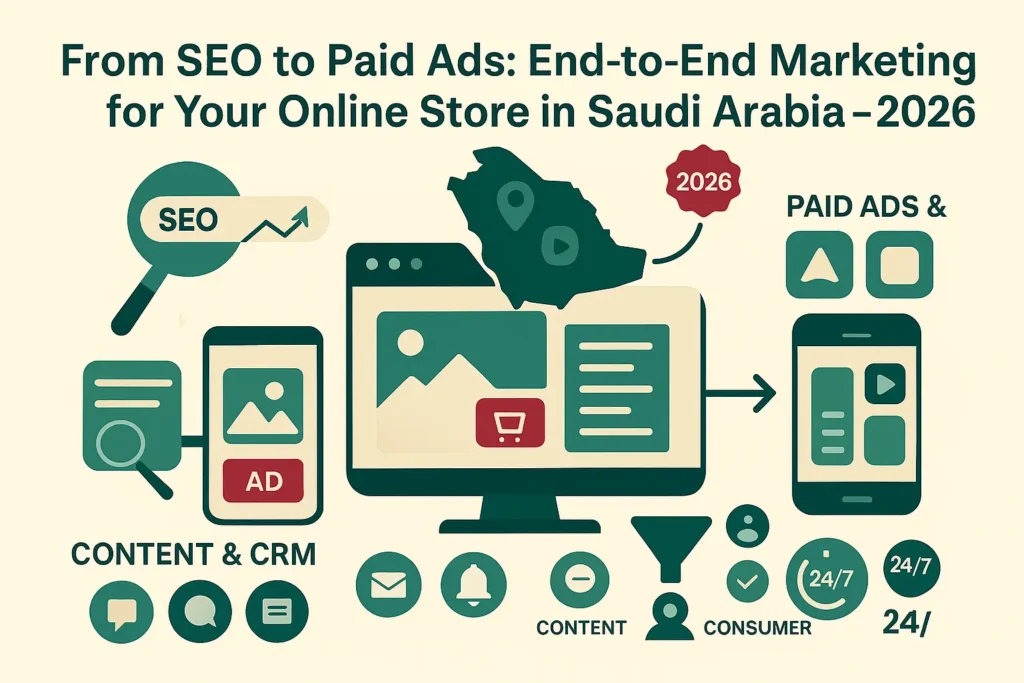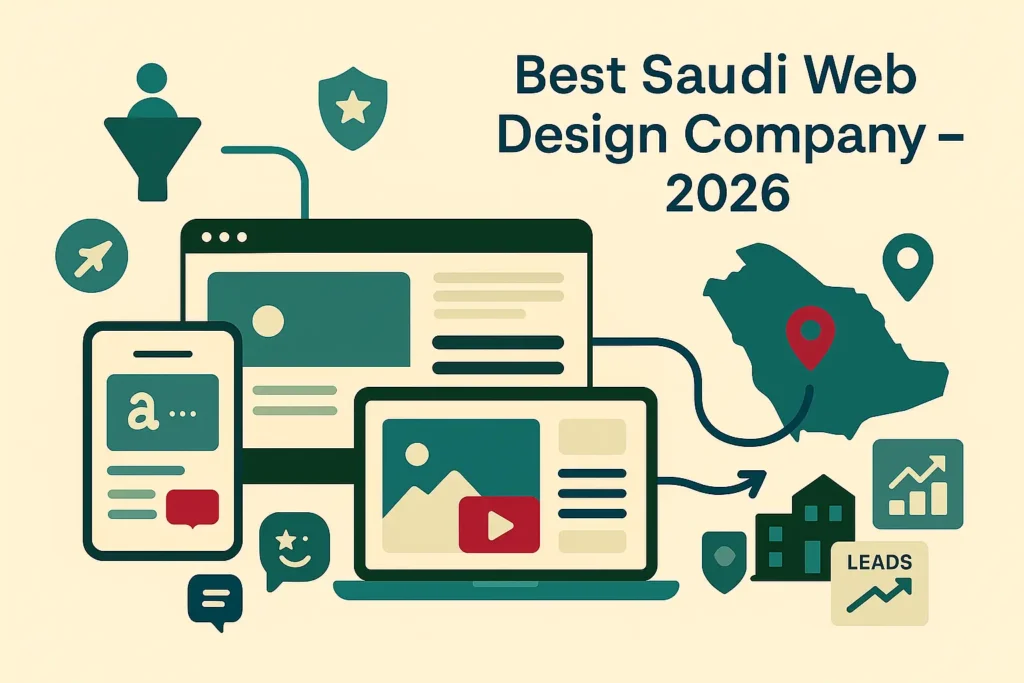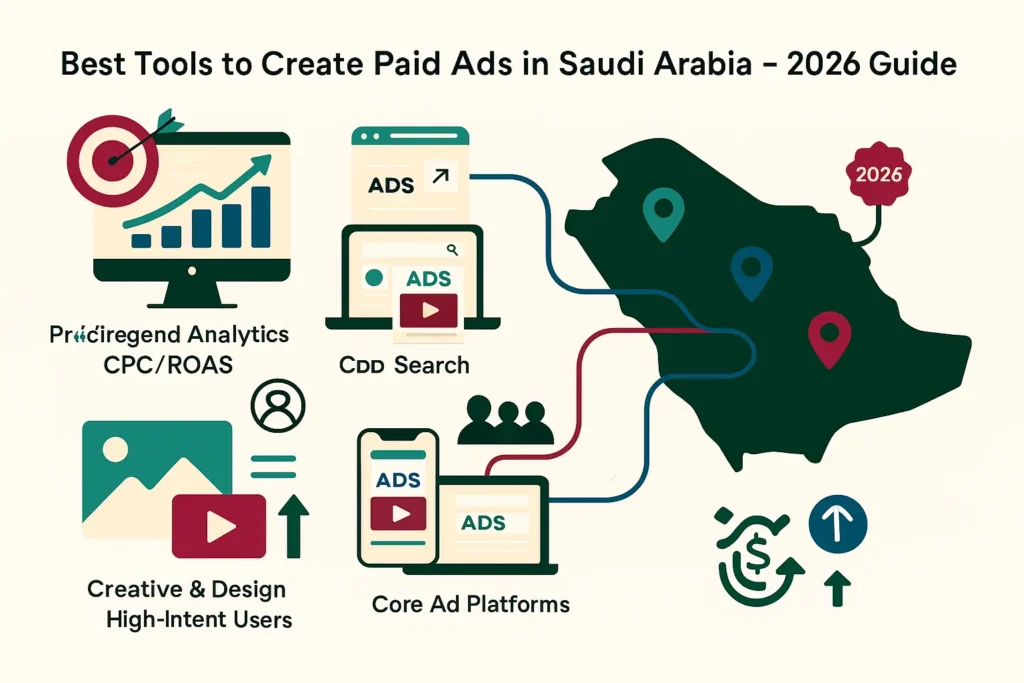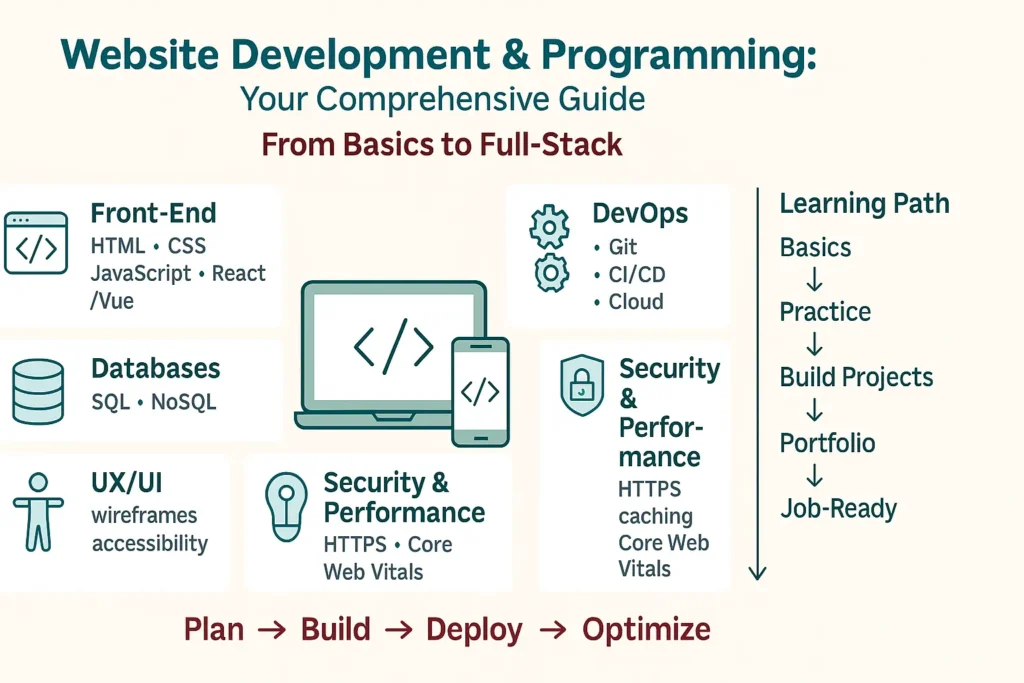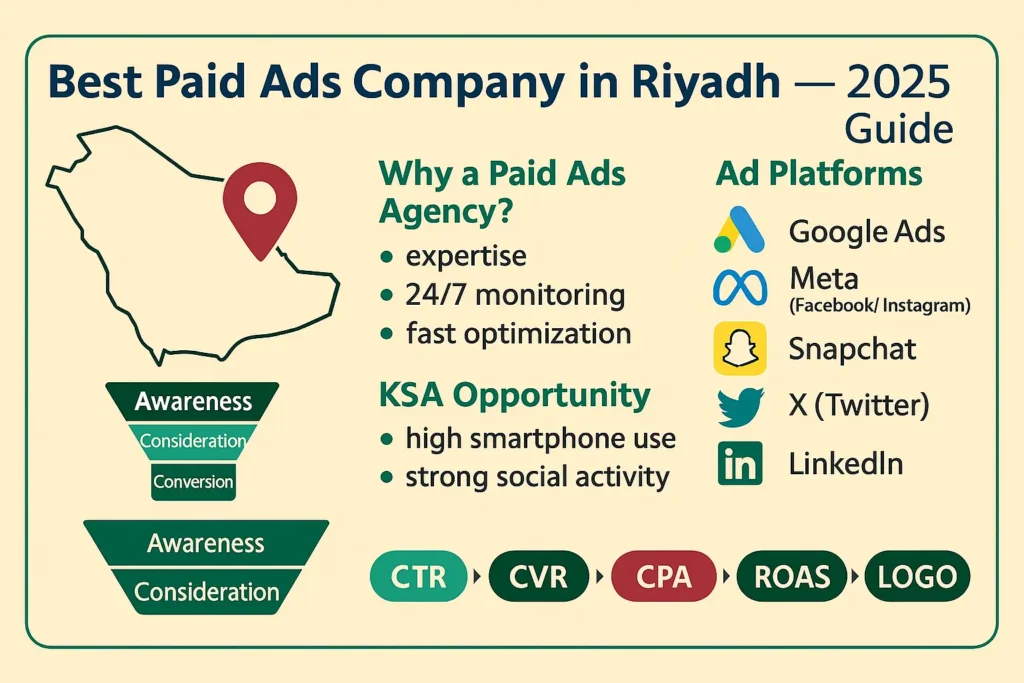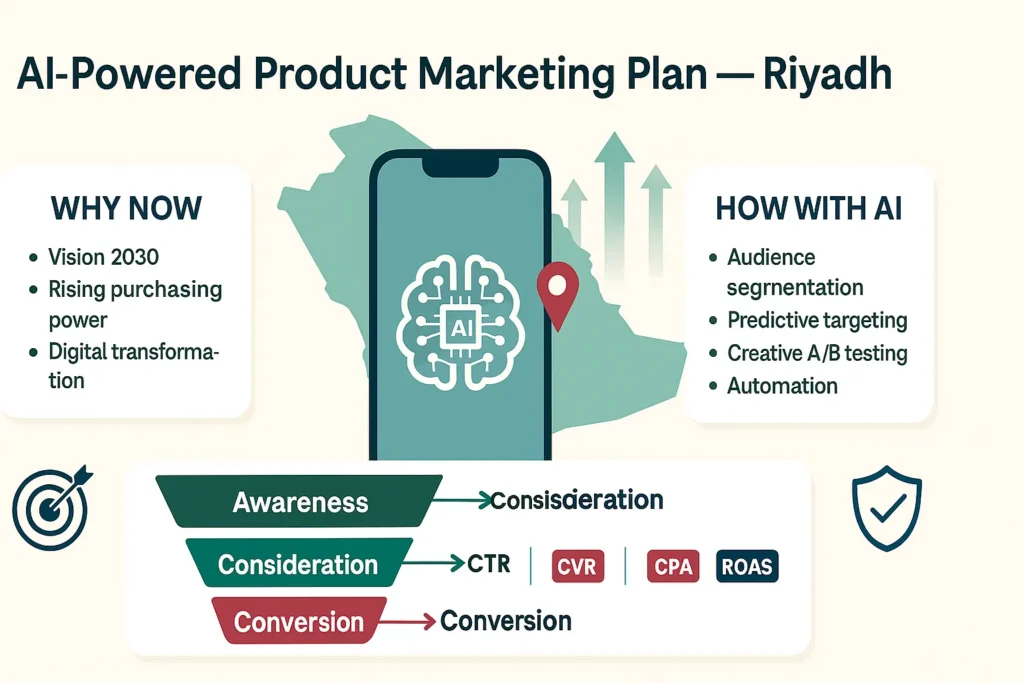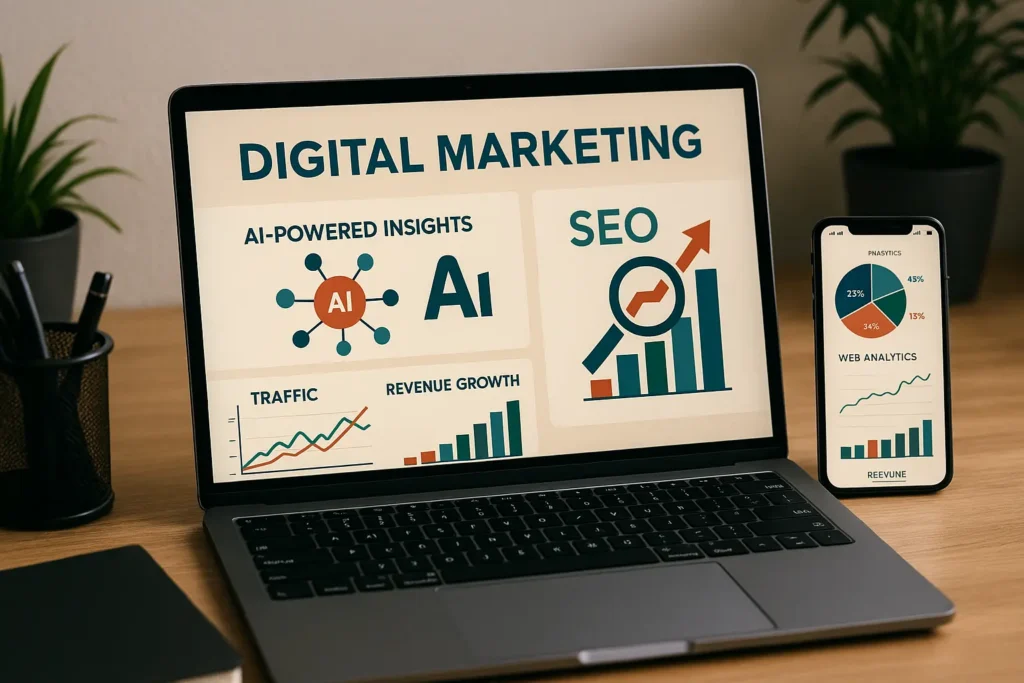
How to Benefit from Digital Marketing and SEO
Why Digital Marketing and SEO Are No Longer Optional
You’re living through the most dramatic business transformation in history. Traditional marketing methods that worked for decades are rapidly becoming obsolete, while businesses that embrace digital marketing and SEO are experiencing unprecedented growth. The statistics paint a clear picture: companies that use comprehensive digital strategies experience 2.8 times better revenue growth than those relying solely on traditional methods.
The shift isn’t just about staying current with trends—it’s about survival. When your customers spend over 4.5 hours daily on their mobile devices and 68% of all online experiences begin with a search engine, your business needs to meet them where they are. Digital marketing and SEO work together as complementary forces, creating a synergistic effect that amplifies your reach, builds authority, and drives sustainable growth.
Consider what happens to businesses that ignore this digital transformation. They become invisible to their target audience, lose market share to more agile competitors, and struggle with declining revenue as their traditional advertising channels become less effective. The COVID-19 pandemic accelerated this shift by nearly a decade, making digital presence not just advantageous but essential for business continuity.
Understanding the Digital Marketing and SEO Foundation
Digital marketing and SEO represent a comprehensive approach to promoting your business through digital channels. Digital marketing encompasses all marketing efforts that use electronic devices or the internet, including search engines, social media, email, mobile apps, and websites. It’s built on the same fundamental principles as traditional marketing but leverages digital technologies to reach, engage, and convert your target audience more effectively.
SEO, or Search Engine Optimization, forms the backbone of sustainable digital visibility. It involves optimizing your website and content to rank higher in search engine results pages, making it easier for potential customers to find you when they’re actively searching for solutions you provide. Unlike paid advertising, SEO builds compound value over time, creating a sustainable stream of organic traffic that doesn’t require ongoing ad spend.
The relationship between digital marketing channels and SEO creates powerful synergies.
Your content marketing efforts support SEO through fresh, valuable content that search engines favor. Social media marketing amplifies your content’s reach, potentially earning valuable backlinks that boost SEO authority. Email marketing nurtures leads who first discovered you through organic search, creating a complete customer journey that maximizes lifetime value.
Your approach to digital marketing and SEO will vary significantly depending on whether you’re targeting businesses (B2B) or consumers (B2C). B2B digital marketing typically requires longer sales cycles, more educational content, and relationship-building strategies. Your SEO might focus on industry-specific keywords and thought leadership content. B2C marketing, conversely, often emphasizes emotional appeals, shorter conversion paths, and broader keyword targeting to capture immediate purchase intent.
Many businesses fall victim to common misconceptions about digital marketing and SEO. Some believe results happen overnight, when in reality, SEO can take 4-6 months to show significant results, while digital marketing campaigns require ongoing optimization. Others think they can “set it and forget it,” missing the dynamic nature of digital platforms where algorithms, competitor actions, and consumer behavior constantly evolve.
The Compelling Benefits of Digital Marketing and SEO
The reach potential of digital marketing and SEO dwarfs traditional marketing channels. You can connect with customers across the globe, in multiple time zones, without geographical limitations. A single piece of optimized content can attract visitors for years, while social media posts can go viral and reach millions of people organically. This global accessibility transforms even small businesses into potential international players.
Cost-effectiveness represents one of the most compelling advantages. Traditional TV commercials, radio spots, and print advertisements require substantial upfront investments with limited tracking capabilities. Digital marketing allows you to start with modest budgets and scale based on performance. SEO, once properly implemented, continues delivering results without ongoing costs per click or impression.
The measurable nature of digital marketing eliminates guesswork from your strategy. You can track exactly how many people saw your content, clicked your links, visited specific pages, and completed desired actions. This data-driven approach lets you calculate precise return on investment, identify your most effective channels, and continuously optimize for better results.
Digital marketing provides unprecedented opportunities for personalization and targeting.
You can segment audiences based on demographics, behaviors, interests, and purchase history, delivering highly relevant messages that resonate with each group.”
Enhanced targeting capabilities mean you’re not wasting resources on uninterested audiences. Instead of broadcasting generic messages hoping someone relevant sees them, you can precisely target people actively searching for your solutions, those who’ve visited your website before, or individuals matching your ideal customer profile.
Your business gains a 24/7 marketing presence that never sleeps. While traditional businesses operate during specific hours, your optimized website, social media profiles, and digital campaigns work continuously. Potential customers in different time zones can discover, research, and even purchase from you at their convenience, dramatically expanding your opportunity window.
Long-term compound growth through SEO creates sustainable competitive advantages. Each piece of optimized content builds on previous efforts, creating a growing library of assets that attract organic traffic. High-quality backlinks accumulate over time, boosting your domain authority and making it easier to rank for competitive keywords. This compound effect means your SEO investment today continues paying dividends for years.
Enhanced brand credibility and authority emerge naturally from strong digital marketing and SEO practices. When your business consistently appears in search results, maintains active social media engagement, and publishes valuable content, you build trust and recognition. Customers perceive businesses with a strong digital presence as more established and reliable than those lacking online visibility.
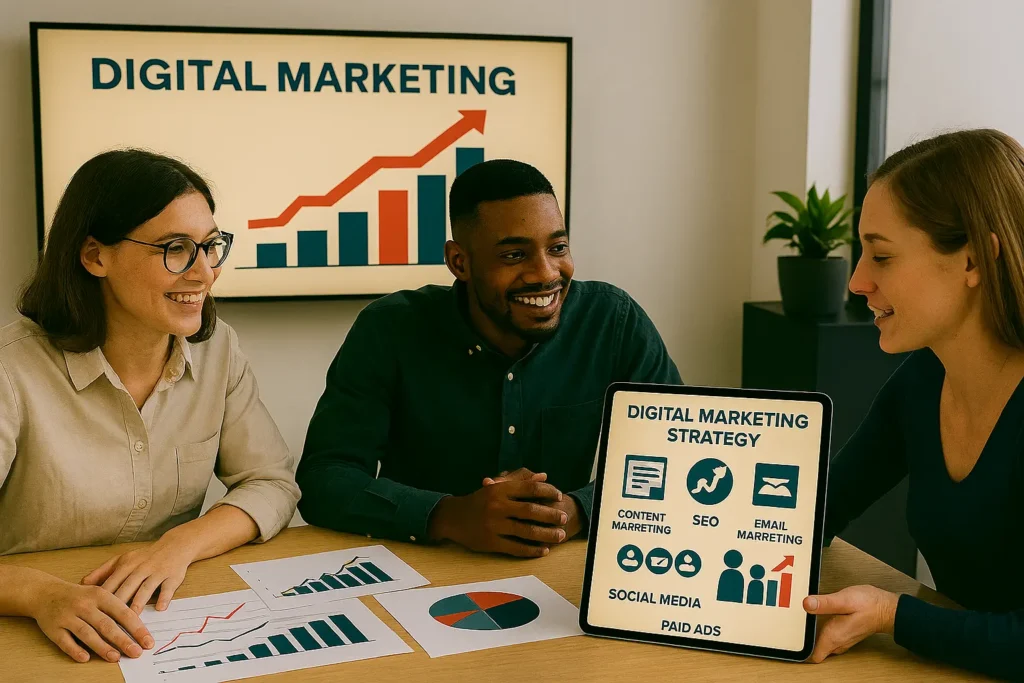
Essential Digital Marketing Strategies That Drive Results
Content marketing forms the foundation of effective digital marketing and SEO strategies. By creating valuable, relevant content that addresses your audience’s questions and challenges, you attract potential customers during their research phase and build trust before they’re ready to buy. Blog posts, guides, videos, and infographics not only engage your audience but also provide fresh content that search engines favor for ranking purposes.
Your content marketing success depends on understanding your audience’s information needs at different stages of their buyer journey. During the awareness stage, they need educational content that helps them understand their problems. In the consideration stage, they want to compare solutions and evaluate options. At the decision stage, they need proof points, testimonials, and detailed product information to make confident purchase decisions.
Social media marketing extends your reach and creates a community around your brand. Different platforms serve different purposes in your overall strategy. LinkedIn works exceptionally well for B2B relationship building and thought leadership, while Instagram and TikTok excel at visual storytelling and reaching younger demographics. Facebook provides robust advertising options and community-building features that support long-term customer relationships.
The key to social media success lies in consistent, authentic engagement rather than purely promotional content. You should aim to provide value in every post, whether through entertainment, education, or inspiration. Responding promptly to comments and messages builds relationships and demonstrates excellent customer service, which can significantly impact your brand reputation.
Email marketing remains one of the highest-ROI digital marketing channels when executed properly.
It allows you to nurture leads over time, providing valuable information that builds trust and positions your business as the logical choice when they’re ready to buy. Advanced segmentation capabilities let you send highly targeted messages based on subscriber behavior, preferences, and position in your sales funnel.
Pay-per-click advertising provides immediate visibility and precise targeting options. Unlike SEO, which builds gradually over time, PPC campaigns can generate traffic and leads within hours of launch. Google Ads, Microsoft Ads, and social media advertising platforms offer sophisticated targeting options that let you reach people based on search intent, demographics, interests, and online behavior.
Strategic partnerships through affiliate and influencer marketing leverage established audiences and trusted relationships. When respected industry figures recommend your products or services, their audiences are more likely to trust your brand by association. These partnerships can dramatically expand your reach into new market segments while benefiting from the influencer’s established credibility.
Mobile marketing has become essential as smartphone usage continues growing. Your digital marketing efforts must be optimized for mobile devices, from responsive website design to mobile-friendly email templates and social media content. Location-based marketing opportunities let you reach potential customers when they’re physically near your business or in relevant geographic areas.
SEO Fundamentals and Best Practices
Effective SEO begins with comprehensive keyword research that uncovers the terms your target audience uses when searching for solutions you provide. You need to balance search volume, competition levels, and commercial intent to identify opportunities where you can realistically achieve rankings. Long-tail keywords often provide better conversion rates than broad terms because they capture more specific search intent.
Your keyword strategy should encompass different types of search queries. Informational keywords target people seeking knowledge or answers to questions. Navigational keywords help people find specific brands or websites. Transactional keywords indicate strong purchase intent. By creating content that targets all three types, you can attract visitors at every stage of their buyer journey.
On-page optimization ensures search engines can understand and properly index your content. This includes optimizing title tags, meta descriptions, header tags, and URL structures using your target keywords naturally. However, modern SEO emphasizes user experience over keyword density. Your content should read naturally while incorporating keywords in strategic locations like headings and early paragraphs.
Technical SEO focuses on your website’s backend performance and structure.
Page loading speed significantly impacts both user experience and search rankings. Mobile responsiveness is crucial since Google uses mobile-first indexing. Clean site architecture with logical navigation helps search engines crawl and index your content efficiently.
Off-page SEO primarily involves building high-quality backlinks from reputable websites in your industry. Search engines view backlinks as votes of confidence, with links from authoritative sites carrying more weight. You can earn backlinks through creating exceptional content, guest posting on relevant websites, building industry relationships, and participating in your professional community.
Local SEO becomes critical if you serve specific geographic areas. Optimizing your Google My Business profile, maintaining consistent NAP (Name, Address, Phone) information across online directories, and earning positive customer reviews help you appear in local search results and Google Maps. Local keywords should reflect how people search for businesses in your area.
Content creation for SEO requires balancing search engine optimization with user value. Search engines increasingly prioritize content that genuinely helps users accomplish their goals. This means focusing on comprehensive, well-researched content that thoroughly addresses search intent rather than thin pages targeting specific keywords.
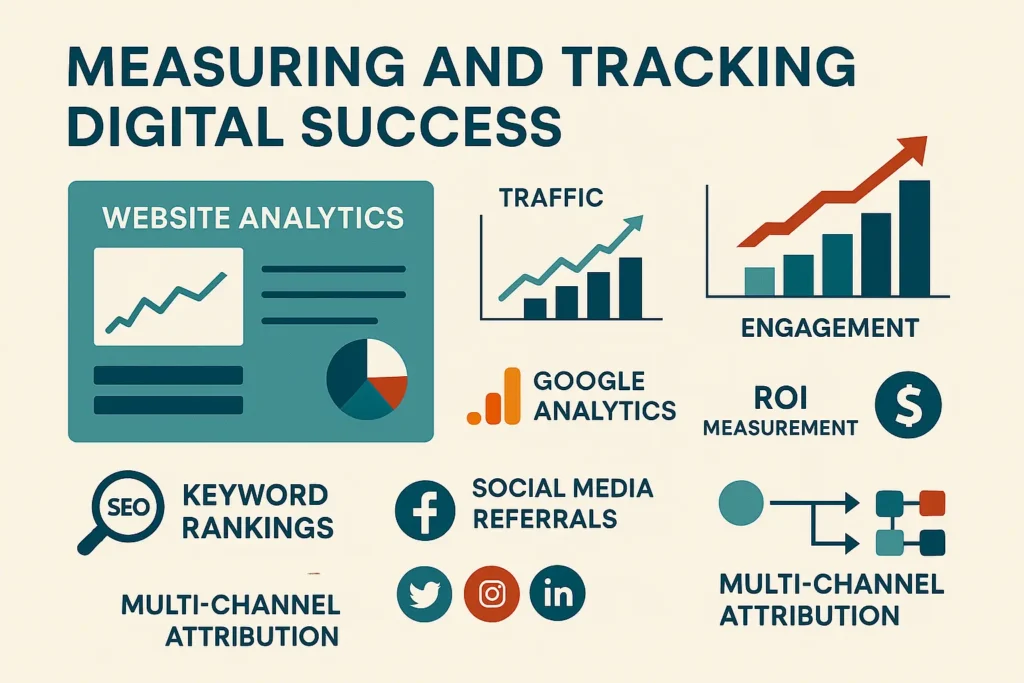
Measuring and Tracking Your Digital Success
Key performance indicators for digital marketing and SEO must align with your business objectives. Traffic metrics like organic search visitors and social media referrals indicate awareness and reach. Engagement metrics such as time on page, bounce rate, and social shares reveal content quality and audience interest. Conversion metrics, including lead generation, sales, and email signups, directly measure business impact.
SEO-specific metrics require a long-term perspective and regular monitoring. Keyword rankings show your visibility for target terms, but rankings can fluctuate daily due to various factors. Organic traffic trends provide better indicators of SEO performance over time. Click-through rates from search results indicate whether your titles and descriptions effectively attract clicks.
Google Analytics provides comprehensive data about your website’s performance, visitor behavior, and conversion paths. Setting up proper goal tracking lets you measure specific actions like form submissions, phone calls, and purchases. Attribution modeling helps you understand how different digital marketing channels work together to drive conversions.
Conversion tracking and attribution become complex in multi-touch customer journeys. A customer might discover you through organic search, follow you on social media, receive your email newsletter, and finally convert through a paid ad. Understanding these paths helps you allocate budget across channels and optimize the entire customer experience.
ROI calculation for digital campaigns requires tracking both direct and indirect benefits.
Direct ROI comes from immediate conversions and sales directly attributable to specific campaigns. Indirect benefits include brand awareness, customer lifetime value increases, and reduced customer acquisition costs through improved organic visibility.
Creating meaningful reports for stakeholders involves translating data into business insights. Rather than overwhelming executives with raw metrics, focus on trends, achievements against goals, and strategic recommendations. Regular reporting schedules help maintain accountability and ensure digital marketing efforts align with broader business objectives.
Keep reading and uncover secrets that can change the way you work. How Search Engine Optimization SEO Doubles Your Online Store’s Profits in Saudi Arabia
Common Challenges and How to Overcome Them
Algorithm changes across search engines and social media platforms create ongoing challenges for digital marketing and SEO strategies. Google makes thousands of algorithm updates annually, some minor and others potentially devastating to unprepared websites. Staying informed through industry publications, following official platform communications, and maintaining diversified traffic sources helps minimize algorithm impact.
The key to algorithm resilience lies in following best practices and focusing on user value rather than gaming systems. Websites that consistently produce high-quality content and maintain excellent user experience typically recover quickly from algorithm changes. Building email lists and social media followings creates direct communication channels that don’t depend on algorithmic distribution.
Competition and market saturation intensify as more businesses
Recognize digital marketing’s importance. Differentiating your brand requires a deep understanding of your unique value proposition and audience needs. Rather than competing solely on price or features, focus on building authentic relationships and delivering exceptional customer experiences that create lasting loyalty.
Budget constraints force difficult decisions about channel priorities and resource allocation. Start with channels that align best with your audience preferences and business model. B2B companies might prioritize LinkedIn and email marketing, while local service businesses could focus on local SEO and Google Ads. Test small, measure results, and scale successful efforts gradually.
Data privacy regulations like GDPR and CCPA complicate tracking and personalization efforts.
Implementing privacy-compliant tracking solutions, obtaining proper consent, and focusing on first-party data collection help navigate regulatory requirements. Transparent privacy policies and ethical data practices build customer trust while ensuring compliance.
Measuring long-term SEO impact requires patience and proper attribution modeling. SEO benefits compound over time, making it difficult to assess short-term ROI. Establish baseline metrics before implementing SEO strategies, track leading indicators like content publication and link building, and maintain consistent measurement periods to identify trends.
Integration challenges across channels often result in disjointed customer experiences and inefficient resource utilization. Developing integrated campaigns where content marketing supports SEO, social media amplifies content reach, and email nurtures organic search visitors creates synergistic effects that maximize your overall marketing impact.
Keep reading and uncover secrets that can change the way you work. Secrets of Successful E-Commerce Marketing: What Your Competitors Are Doing That You Don’t Know?
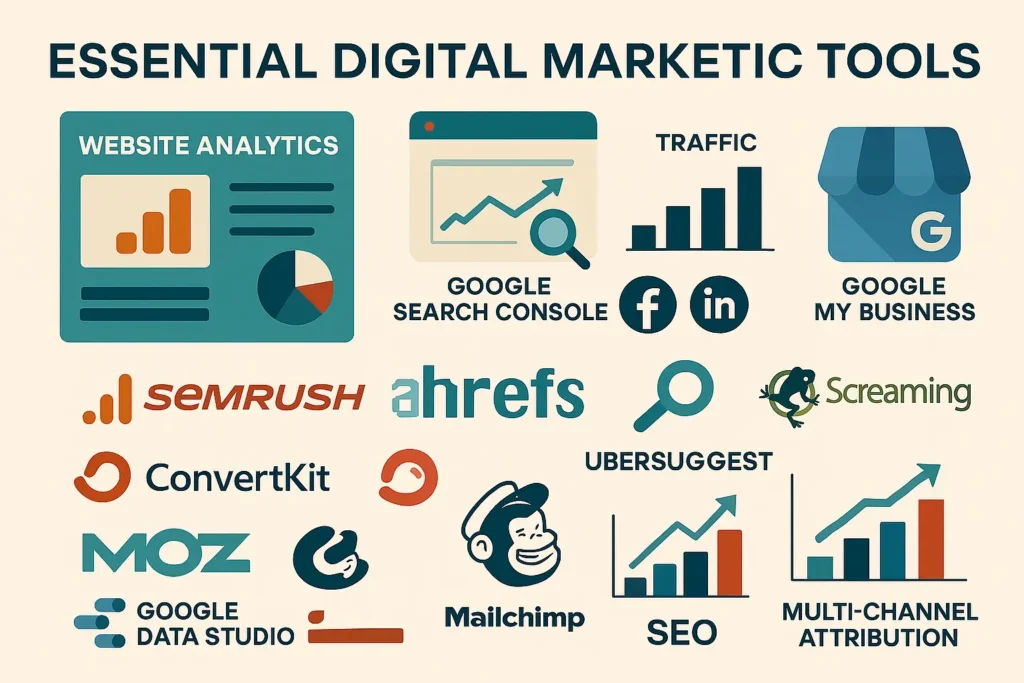
Essential Tools and Platforms to Get Started
Free digital marketing tools provide excellent starting points for businesses with limited budgets. Google Analytics offers comprehensive website performance tracking and user behavior insights. And Google Search Console reveals how your site performs in search results and identifies technical issues. Google My Business helps local businesses manage their online presence and customer reviews.
Social media platforms provide native analytics and posting tools that handle basic social media marketing needs. Facebook Creator Studio, LinkedIn Publishing, and Twitter Analytics offer insights into post-performance and audience engagement. These built-in tools often provide sufficient functionality for small businesses starting their digital marketing journey.
Premium platforms justify their investment through advanced features and time savings. Tools like SEMrush or Ahrefs provide comprehensive keyword research, competitor analysis, and backlink tracking capabilities. HubSpot offers integrated marketing automation that connects email marketing, lead scoring, and customer relationship management.
SEO tools range from free browser extensions to enterprise-level platforms.
Ubersuggest provides keyword ideas and basic competitor analysis at an affordable price point. Screaming Frog analyzes technical SEO issues across your entire website. Moz offers beginner-friendly SEO tools with extensive educational resources.
Email marketing software has evolved far beyond basic newsletter sending. Mailchimp provides excellent automation capabilities and integrations for small businesses. ConvertKit specializes in creator economy businesses with advanced segmentation options. Enterprise solutions like Pardot or Marketo offer sophisticated lead scoring and attribution modeling.
Analytics and reporting tools help consolidate data from multiple sources into actionable insights. Google Data Studio creates custom dashboards combining data from various platforms. Supermetrics automates data collection from different marketing channels into spreadsheets or business intelligence tools. These solutions save significant time while improving decision-making capabilities.
Keep reading and uncover secrets that can change the way you work. Best Digital Marketing Company: Professional Team and 24/7 Customer Service – Your Gateway to Unstoppable Growth
Creating an Integrated Digital Marketing and SEO Strategy
Developing detailed buyer personas forms the foundation of an effective digital marketing and SEO strategy. You need a deep understanding of your ideal customers’ demographics, psychographics, pain points, and decision-making processes. This information guides everything from keyword selection to content topics to social media platform choices.
Customer journey mapping reveals how prospects interact with your brand across multiple touchpoints. The modern customer journey rarely follows a linear path from awareness to purchase. Instead, people might discover you through social media, research on your website, subscribe to your email list, and convert weeks later through a Google search. Understanding these patterns helps optimize each touchpoint for maximum impact.
Aligning digital marketing goals with business objectives ensures your efforts contribute meaningfully to organizational success. If your business prioritizes customer retention, your digital strategy should emphasize email marketing and social media engagement. Companies focused on rapid growth might prioritize paid advertising and conversion optimization.
Content calendars that support SEO require strategic planning
around keyword opportunities, seasonal trends, and business priorities. Your editorial calendar should include a mix of educational content targeting top-of-funnel keywords, comparison content for middle-funnel searches, and product-focused content for bottom-funnel queries.
Cross-channel promotion and amplification multiply the impact of your content investments. A single blog post can become multiple social media posts, email newsletter content, and even video scripts. Repurposing content across channels increases reach while maintaining consistent messaging that reinforces key points.
Budget allocation across digital channels should reflect your audience preferences and business model characteristics. B2B companies typically see better results investing heavily in content marketing and LinkedIn advertising. E-commerce businesses might prioritize Google Shopping ads and Instagram marketing. Service-based businesses often benefit from local SEO and Google Ads investment.
Keep reading and uncover secrets that can change the way you work. Top Search Engine Marketing Solutions for Businesses in Riyadh – AI-Driven Campaigns
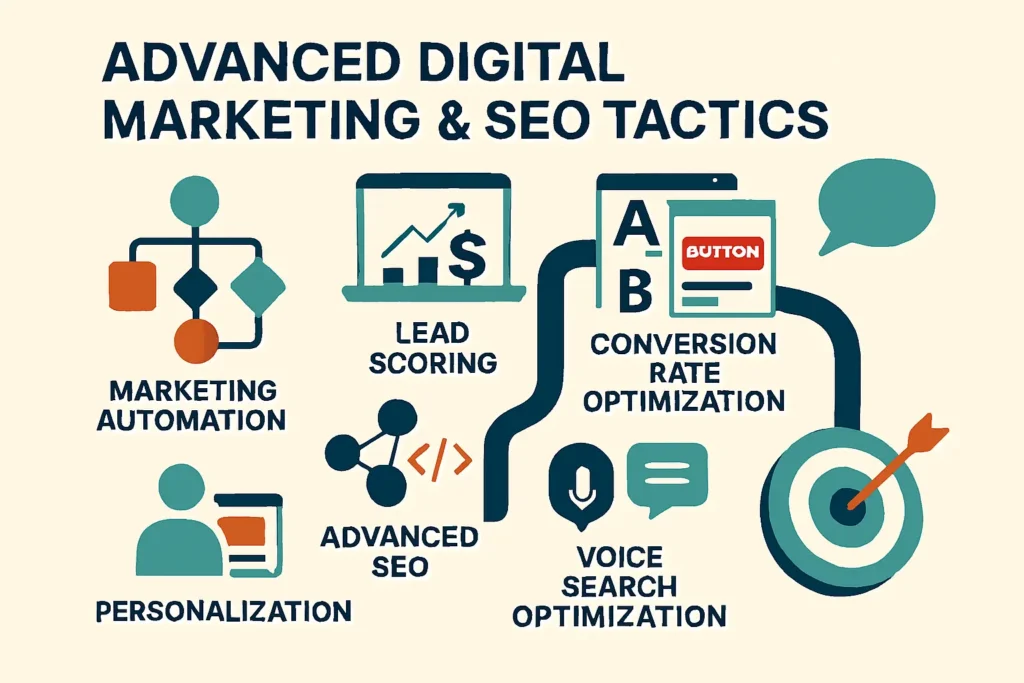
Advanced Tactics for Maximum Impact
Marketing automation transforms how you nurture leads and maintain customer relationships at scale. Sophisticated workflows can deliver personalized content based on specific behaviors, send targeted offers to high-value prospects, and re-engage inactive subscribers automatically. These systems handle routine communications while you focus on strategy and relationship building.
Lead scoring systems help prioritize sales efforts by identifying prospects most likely to convert. By assigning point values to different actions like website visits, content downloads, and email engagement, you can focus attention on qualified leads while continuing to nurture others through automated sequences.
Advanced SEO techniques become necessary in highly competitive markets. Topic cluster strategies organize content around pillar pages that target broad keywords, with supporting cluster content targeting related long-tail terms. Technical implementations like schema markup help search engines understand your content context and may enable rich snippets in search results.
Conversion rate optimization focuses on improving
The percentage of visitors who complete desired actions. A/B testing different headlines, button colors, form lengths, and page layouts reveals what resonates best with your audience. Small improvements in conversion rates can significantly impact overall marketing ROI.
Personalization and dynamic content delivery create more relevant user experiences that improve engagement and conversions. Showing different content based on visitor location, referral source, or previous behavior makes your website more relevant and valuable. Email personalization extends beyond using names to include product recommendations and customized content.
Voice search optimization prepares your digital marketing and SEO strategy for changing search behaviors. Voice queries tend to be longer and more conversational than typed searches. Optimizing for question-based keywords and creating content that directly answers common questions positions you for voice search success.
Video marketing and visual content strategies acknowledge changing content consumption preferences. Video content generates significantly more engagement than text-only posts across social media platforms. Creating educational videos, product demonstrations, and behind-the-scenes content helps build stronger connections with your audience while providing additional optimization opportunities.
Keep reading and uncover secrets that can change the way you work. The best digital marketing services for entrepreneurs in the Arab world
Building Your Path to Digital Marketing Success
Creating realistic timelines for digital marketing and SEO results helps set appropriate expectations and maintain long-term commitment. Paid advertising can generate immediate traffic and leads, while SEO typically requires 4-6 months to show significant results. Content marketing builds momentum over time, with compound benefits that increase as your content library grows.
Your timeline should account for industry competitiveness, current digital presence, and resource availability. Businesses in highly competitive markets need longer timeframes and more substantial investments to achieve significant results. Companies with existing digital assets can often see faster progress than those starting from scratch.
Building internal capabilities versus outsourcing represents a strategic decision with long-term implications. Developing in-house expertise provides better control and institutional knowledge but requires significant time and training investments. Outsourcing offers immediate access to specialized skills but may cost more and provide less direct control.
Many businesses find hybrid approaches most effective, handling basic tasks internally while outsourcing specialized technical work or strategy development. This approach builds internal knowledge while leveraging expert capabilities for maximum impact.
Scaling successful campaigns and tactics
requires a systematic approach to expansion. Once you identify high-performing content topics, keywords, or advertising campaigns, you can invest additional resources to maximize their impact. Scaling might involve creating more content around successful topics, increasing budgets for profitable ad campaigns, or expanding successful local SEO strategies to new geographic areas.
Staying ahead of digital marketing trends requires continuous learning and adaptation. Following industry thought leaders, attending conferences, and participating in professional communities keep you informed about emerging opportunities and threats. The digital landscape evolves rapidly, making ongoing education essential for sustained success.
Continuous optimization and adaptation ensure your strategies remain effective as markets and technologies evolve. Regular performance reviews, competitor analysis, and customer feedback help identify improvement opportunities. The most successful digital marketers treat their efforts as ongoing experiments rather than set-and-forget campaigns.
Keep reading and uncover secrets that can change the way you work. How Digital Marketing Is Changing the Business Landscape
Frequently Asked Questions (FAQ)
How long does it take to see results from digital marketing and SEO?
Your timeline for seeing results varies significantly depending on the specific tactics you’re implementing and your starting position. Paid advertising campaigns through Google Ads or social media platforms can generate immediate traffic and leads, often within hours of launching. However, these results stop when you stop paying, making them best suited for short-term goals or supporting longer-term strategies.
SEO represents the opposite timeline, typically requiring 4-6 months before you see significant improvements in organic search rankings and traffic. This extended timeline reflects how search engines evaluate websites, the time needed to build authority through content creation and link building, and the competitive nature of most markets. However, SEO benefits compound over time, creating sustainable long-term value that continues growing.
Content marketing and social media marketing fall somewhere between these extremes. You might see engagement and traffic improvements within weeks of consistent posting, but building a substantial audience and generating meaningful leads typically takes 3-6 months of consistent effort. The key lies in maintaining realistic expectations while staying committed to your long-term strategy.
What’s the minimum budget needed to start with digital marketing?
You can begin digital marketing and SEO with minimal financial investment, focusing initially on time and effort rather than paid advertising. Creating valuable content, optimizing your website for search engines, and engaging on social media platforms requires primarily time investment. Many successful businesses started their digital marketing journey with budgets under $500 monthly.
For paid advertising, starting budgets depend on your industry and goals. Local service businesses might see meaningful results with $300-500 monthly Google Ads spending, while competitive e-commerce markets might require $1000+ monthly investments to generate a significant impact. The key is starting small, measuring results carefully, and scaling based on performance rather than arbitrary budget increases.
Tool investments can remain modest initially. Many essential tools offer free tiers that provide sufficient functionality for small businesses. Google Analytics, Google Search Console, and basic social media management tools cost nothing to start. As your efforts scale and become more sophisticated, premium tool investments typically pay for themselves through improved efficiency and results.
Should I focus on SEO or paid advertising first?
Your decision between prioritizing SEO or paid advertising should align with your business needs, timeline, and resources. If you need immediate results to support cash flow or test market demand, paid advertising provides faster feedback and quicker returns. This approach works particularly well for product launches, seasonal businesses, or companies needing to validate their value proposition quickly.
SEO makes more sense as a primary focus if you’re building for long-term success and have the patience to wait for results. Companies with strong cash flow, established customer bases, or those in industries where trust and authority matter significantly often benefit more from SEO-first strategies. The compound benefits of SEO create sustainable competitive advantages that become increasingly valuable over time.
The most effective approach often involves parallel investment in both strategies, with different emphasis based on your immediate needs. Using paid advertising for immediate results while building an SEO foundation creates the best of both worlds. Paid campaigns can generate quick wins and cash flow to fund longer-term SEO investments.
How do I know if my digital marketing efforts are working?
Measuring digital marketing and SEO success requires tracking metrics that align with your business objectives. Website traffic increases indicate growing awareness and reach, but traffic alone doesn’t guarantee business success. You need to monitor how that traffic converts into leads, sales, and customer relationships that drive revenue growth.
Lead generation metrics reveal whether your digital marketing attracts qualified prospects. Track form submissions, email subscriptions, phone calls, and other inquiry types that indicate genuine interest. Quality matters more than quantity—100 highly qualified leads typically provide more value than 1000 unqualified visitors.
Revenue attribution connects your digital marketing efforts directly to business outcomes. Use tracking tools to identify which channels, campaigns, and content pieces contribute most to sales. Customer lifetime value calculations help you understand the long-term impact of different marketing channels.
Engagement metrics provide early indicators of content and campaign effectiveness. Social media engagement, email open rates, time spent on website pages, and content sharing all suggest whether your messaging resonates with your target audience. These leading indicators often predict future conversion improvements.
Can I do digital marketing and SEO myself, or do I need to hire experts?
Many aspects of digital marketing and SEO can be learned and implemented by business owners, particularly during the early stages when budgets are limited and learning about your market is crucial. Creating content, managing social media accounts, and basic website optimization are accessible to most people willing to invest time in learning.
However, certain technical aspects and advanced strategies benefit significantly from professional expertise. Technical SEO, paid advertising optimization, marketing automation setup, and competitive strategy development often require specialized knowledge that takes years to develop. The complexity and time investment required for mastering these skills often exceed what most business owners can reasonably manage.
A hybrid approach often provides the best balance of control, cost-effectiveness, and results. Handle content creation, social media engagement, and basic optimization internally while outsourcing technical implementation, paid advertising management, or strategic planning to specialists. This approach builds internal knowledge while leveraging expert capabilities for maximum impact.
Consider your opportunity cost when making these decisions. Time spent learning advanced digital marketing techniques might be better invested in product development, customer service, or business operations where your expertise provides more value. The key lies in honestly assessing your interests, capabilities, and available time against the potential returns from different approaches.
Turn your goals into real achievements with our tailored services – request the service now.
Your Digital Marketing Journey Starts Now
The digital marketing landscape offers unprecedented opportunities for businesses willing to embrace change and invest in long-term success. You now understand how digital marketing and SEO work together to create sustainable competitive advantages, build meaningful customer relationships, and drive measurable business growth. The question isn’t whether you should implement these strategies—it’s how quickly you can begin and how effectively you can execute.
Your success depends on taking systematic action rather than trying to implement everything simultaneously. Choose 2-3 channels that align best with your audience and business model. Focus on creating consistent, valuable content that addresses real customer needs. Measure your results carefully and optimize based on data rather than assumptions.
Remember that digital marketing is a marathon, not a sprint. The businesses that achieve the most impressive results are those that maintain consistent effort over months and years, continuously learning and adapting their approach based on performance and market changes. Your commitment to ongoing improvement and customer value creation will determine your ultimate success in the digital marketplace.
The tools, strategies, and knowledge you need are readily available. The only remaining variable is your willingness to begin and persist through the learning process. Start today with one small step, whether that’s optimizing your website’s title tags, publishing your first blog post, or setting up Google Analytics. Your future customers are already searching for solutions you provide—make sure they can find you.
